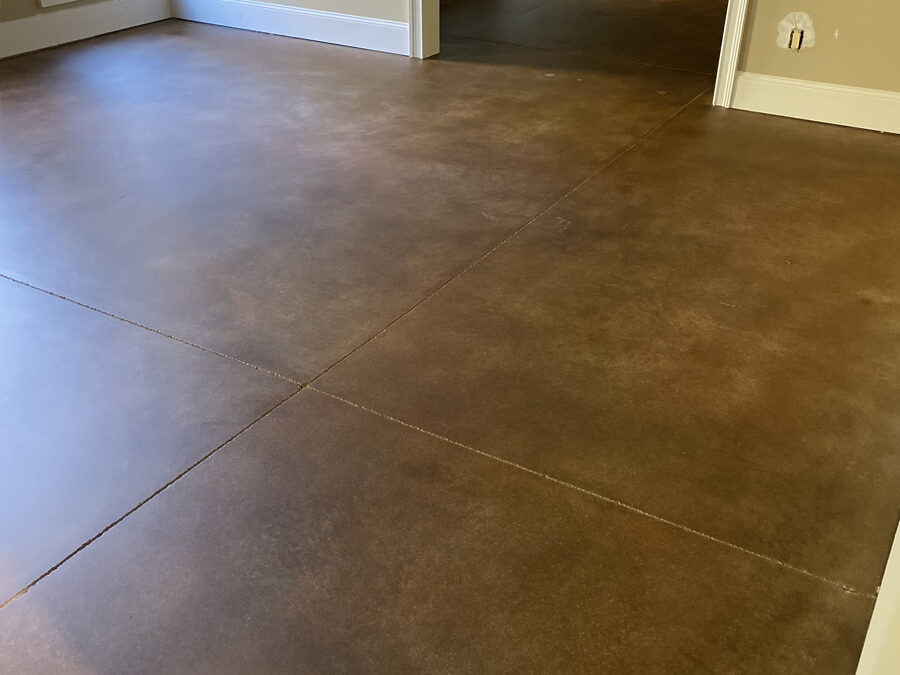Concrete Stains and Concrete Resurfacing Explained
A concrete stain is a colored solution applied to concrete to give it color. There are unlimited color options ranging from earth tones to pastels. Stains can create many color effects for indoor or outdoor spaces.
Resurfacing concrete often includes a stain. Resurfacing makes stains last longer and adds a host of benefits. The key to resurfacing is the addition of a texturizing product and at least two coats of water-based sealer, and “shark grip” (a micronized polymer) or extra slip resistance and glossy finish.
Resurfacing is an exceptional choice for outdoor settings because it offers a sandpaper-like texture to enhance traction. We can also add silica, quartz, or flakes to improve texture.
Stains for concrete are not like stains for wood. Often people confuse wood sealers that include a stain used on wooden decks with concrete resurfacing. When a stain is added to concrete, it does not create a protective coating. Exposure to the elements and use over time deteriorate stains on concrete. The color will fade. We use sealants to protect the stain color and effect.
Concrete staining is a quick and inexpensive technique used to enhance the aesthetic appearance of the concrete surface. It is a type of flooring that involves pouring a water-based solution onto a washed concrete surface, which later becomes a permanent part of the concrete surface.
Stains can fade and wear off over time, so sealers are used to protect them. The highly absorbent property of concrete allows it to stain in almost any color imaginable. Concrete can be stained in various hues and tones using different solutions and techniques.
Concrete stains do not remove flaws, cracks, or unwanted stains. These problems will show through a stain.
Sealants are Key
There must be a sealant to maintain the color and look of a new coating on concrete. Adding a clear coat helps the stain stay with the concrete forever.
With sealing, many driveways are brought back to life and kept looking great for years. Once your old driveway or patio is sealed, it rarely needs maintenance.
Resurfacing can take an old, black, cracked concrete driveway and make it look new.
Process for staining and resurfacing concrete
Proper staining and resurfacing takes time, some skill, and the right tools. Carolina Concrete Medic’s first step is to thoroughly clean as much dirt and existing unwanted stains as possible. We use grinding tools and unique cleaning products to help with this.
Next, we seal any concrete cracks with a flexible joint sealant.
Cleaning and crack healing is followed by buffing.
The stain is applied using sprayers or brushes based on the desired color and effect. The stain is left to dry for at least ten hours. Weather plays a significant role in drying. Often multiple layers of color will be applied to get the perfect desired outcome.
The final step involves the application of a sealer. It’s essential to protect the color and finish to prevent fading. We use at least two coats of sealer to ensure longevity.
The price for sealing is very reasonable. On average, 5,000 feet of surface costs $5,000. New concrete pours for the same area would cost up to $20,000.
Once sealed, expect to get another twenty years out of the driveway or other surface with easy maintenance.

Concrete Stain Pros and Cons
- Available in about any color, hue, and tone imaginable
- It brings old or new concrete to life and improves the aesthetic appeal
- Efficient maintenance
- Stain can also be used in combination with other surface finishes.
- Staining offers aesthetic enhancement of concrete but does not cover nasty stains, cracks, or discoloration. Staining alone does not protect concrete or increase durability.


